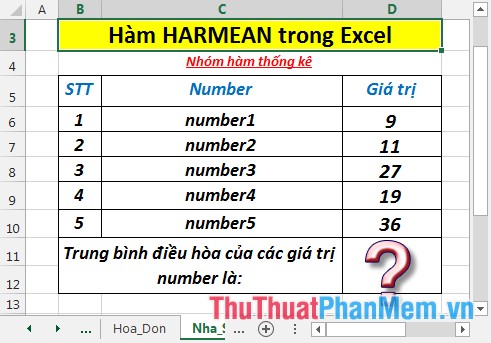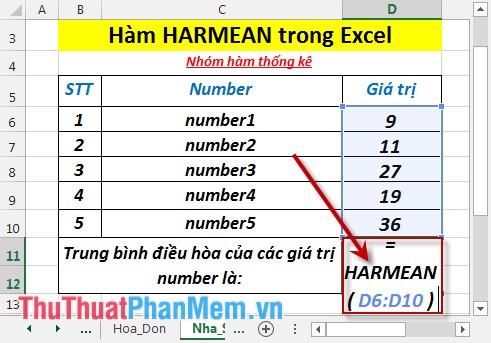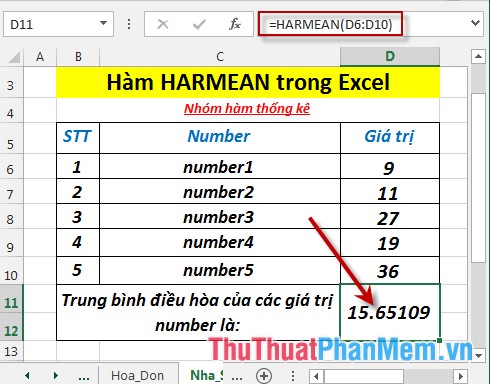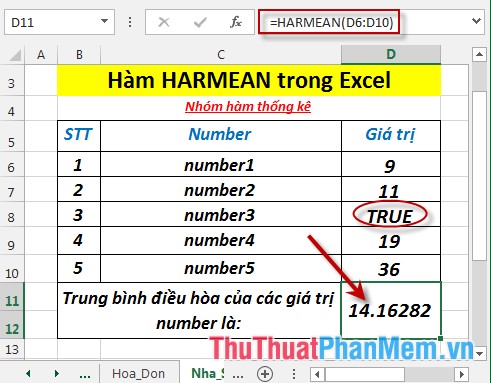HARMEAN function - The function returns the harmonic average of a data set in Excel
The following article introduces you to HARMEAN function - one of the functions in the statistical function group is very popular in Excel.

Description: The function returns the harmonic mean of a dataset, the harmonic mean is the reciprocal of the arithmetic mean of the reciprocals.
Syntax: HARMEAN (number1, [number2], .)
Inside:
- number1, [number2], .) : The values you want to calculate the harmonic mean value, where number1 is the required parameter, the remaining values are optional and contain up to 255 number parameters .
Attention:
- Note: harmonic average
- Arguments can be numbers, names or arrays that contain numbers.
- When typing logical values or textual numbers directly -> these values are still counted.
- If the reference argument or array contains logical values or text -> these values are ignored, but a value of 0 is still counted.
- The value of the argument is a text or an error value that cannot be converted. The function will report an error.
- If any data point ≤ 0 -> the function returns the #NUM! Error value
- The average harmonic equation is:
[frac {1} {{{H_y}}} = frac {1} {n} sum {frac {1} {{{Y_i}}}}]]
For example:
Calculate the harmonic mean of number values in the following data table:

- In the cell to calculate enter the formula : = HARMEAN (D6: D10)

- Press Enter -> harmonic average of number values is:

- Where number values are logical or text values -> they are ignored:

Above are instructions and some specific examples when using HARMEAN function in Excel.
Good luck!
You should read it
- How to use the DAVERAGE function in Excel
- AVEDEV function - The function returns the average absolute deviation of data points from their midpoint in Excel
- Basic Excel functions that anyone must know
- AVERAGE function - The function returns the average of the arguments in Excel
- COVARIANCE.P function - The function returns the covariance of a set, the product of the average of degrees of instruction for each pair of data points in Excel
- AVERAGEIF function - The function returns the average of the arguments with the conditions specified in Excel
- WEIBULL function - The function returns the Weibull distribution in Excel
- AVERAGEIF function (returns the average value according to the condition) in Excel
May be interested
- AVERAGEIFS function - The function returns the average of the arguments that meet multiple conditions in Excel
 averageifs function: the function returns the average of the arguments that meet multiple conditions. syntax: averageifs (average_range, criteria_range1, criteria1, [criteria_range2, criteria2], ...)
averageifs function: the function returns the average of the arguments that meet multiple conditions. syntax: averageifs (average_range, criteria_range1, criteria1, [criteria_range2, criteria2], ...) - NORM.S.INV function - The function returns the inverse of the normalized distribution with an average value of 0 and a standard deviation of 1 in Excel
 norm.s.inv function: the function returns the inverse of the normalized distribution with an average value of 0 and a standard deviation of 1. support from excel 2010 onwards. syntax: norm.s.inv (probability)
norm.s.inv function: the function returns the inverse of the normalized distribution with an average value of 0 and a standard deviation of 1. support from excel 2010 onwards. syntax: norm.s.inv (probability) - How to use the AVERAGE function in Excel
 average function on excel will calculate the average of the data in the spreadsheet.
average function on excel will calculate the average of the data in the spreadsheet. - How to use AVERAGEIF function in Excel
 averageif function on excel is a conditional plus average function in the data table, with the given conditions set by the user.
averageif function on excel is a conditional plus average function in the data table, with the given conditions set by the user. - DEVSQ function in Excel The function returns the sum of squares of deviations between data points from their average
 devsq () is a function that returns the sum of squares of deviations between data points from their average.
devsq () is a function that returns the sum of squares of deviations between data points from their average. - How to use the NORMDIST function in Excel - Function that returns the distribution in Excel
 the normdist function returns a distribution with a specified mean and standard deviation. the normdist function has applications in statistics, including hypothesis testing.
the normdist function returns a distribution with a specified mean and standard deviation. the normdist function has applications in statistics, including hypothesis testing. - COVARIANCE.S function - Returns the covariance pattern, the average of product deviations for each pair of data points in two data sets in Excel
 covariance.s function: returns the covariance, the product of the deviations for each pair of data points in two data sets syntax: covariance.s (array1, array2)
covariance.s function: returns the covariance, the product of the deviations for each pair of data points in two data sets syntax: covariance.s (array1, array2) - How to use NORMDIST function in Excel
 normdist is a function that returns a distribution with a standard deviation and a confirmed average. the normdist function applies in statistics, including hypothesis testing.
normdist is a function that returns a distribution with a standard deviation and a confirmed average. the normdist function applies in statistics, including hypothesis testing. - NORMDIST function - The function returns the normal distribution with the standard deviation and the average value specified in Excel
 the following article details the normdist function - the function returns the normal distribution in excel.
the following article details the normdist function - the function returns the normal distribution in excel. - RANK.AVG function - The function returns the rank of a number in a list of numbers in Excel
 rank.avg function: the function returns the rank of a number in a list of numbers whose size is in correlation with other values. if multiple values have the same rank -> the function returns the average rank. support functions from execl 2010 version and above
rank.avg function: the function returns the rank of a number in a list of numbers whose size is in correlation with other values. if multiple values have the same rank -> the function returns the average rank. support functions from execl 2010 version and above










 HYPGEOM.DIST - The function returns the hyperbolic distribution in Excel
HYPGEOM.DIST - The function returns the hyperbolic distribution in Excel KURT function - The function returns the sharp coefficient of a dataset in Excel
KURT function - The function returns the sharp coefficient of a dataset in Excel LARGE function - The function returns the kth largest value in a dataset in Excel
LARGE function - The function returns the kth largest value in a dataset in Excel LOGEST - The function returns an array of data that describes an exponential curve that fits the data given in Excel
LOGEST - The function returns an array of data that describes an exponential curve that fits the data given in Excel LOGNORM.DIST - Function returns the logarithmic distribution of x in Excel
LOGNORM.DIST - Function returns the logarithmic distribution of x in Excel LOGNORM.INV function - The function returns the inverse of the logarithmic distribution of x in Excel
LOGNORM.INV function - The function returns the inverse of the logarithmic distribution of x in Excel